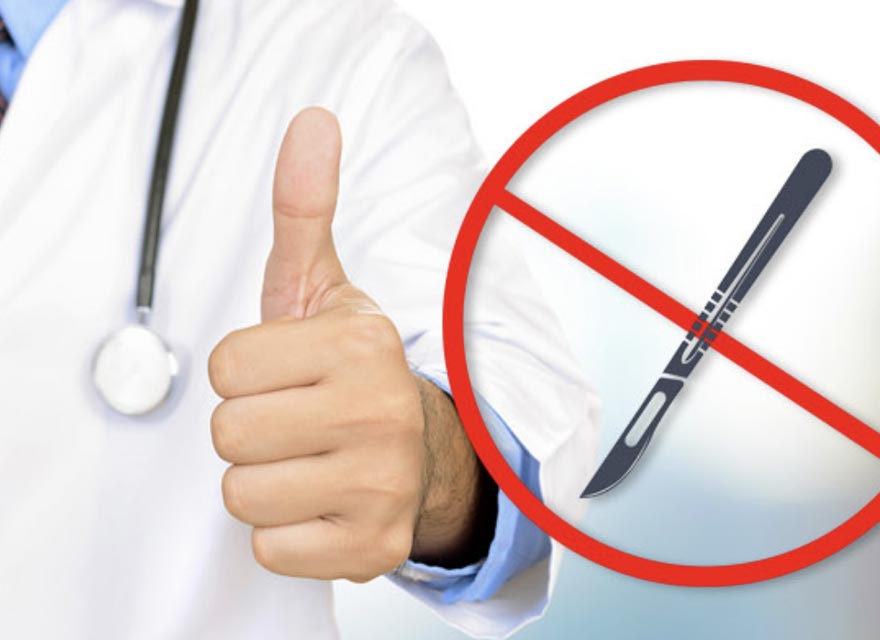If you’ve been thinking about getting a vasectomy, chances are you’ve come across two main types: the traditional vasectomy and the no-scalpel vasectomy. While both methods aim to achieve the same goal (permanent male contraception) the way they’re performed, how you recover, the complication rate, the failure rate and what you experience along the way can be quite different.
At Dr Snip, we specialise in the no-scalpel technique, and this article will walk you through how it compares to the traditional method, so you can make an informed, confident decision about your reproductive health.
Understanding the Basics: What is a No-Scalpel Vasectomy?
A no-scalpel vasectomy is a modern, minimally invasive method that uses a specialised instrument to access the vas deferens (the tube that carries sperm) through a small puncture in the skin. There’s no need for stitches, no need for a general anaesthetic and the skin seals on its own. The vas is then cut, sealed internally and covered to stop sperm from being included in semen.
It’s fast, low on discomfort, requires less recovery time and has lower complication and failure rates than the traditional approach.
At Dr Snip, no-scalpel vasectomy is our standard technique and has been used in over 50,000 procedures with excellent results.
Traditional Vasectomy: How the Procedure Works
The traditional vasectomy involves making one or two incisions in the scrotum using a scalpel to access the vas deferens. The tubes are then cut and sealed, and the incisions then need to be stitched closed. This method is effective, but it tends to involve more discomfort, a higher risk of infection, a longer recovery period. In Australia most are also performed this way under general anesthesia with its associated risks. In the USA and Canada clinics have moved away from this approach in favour of the less invasive and quicker alternative.
Key Differences: No-Scalpel vs. Traditional Vasectomy
While the goal is the same, the key differences between the two methods lie in how the surgeon accesses the vas deferens. The no-scalpel approach uses a single small opening, whereas the traditional method involves a much longer cut(s) and sutures. This small but important distinction has a big impact on pain, recovery time, and overall patient comfort.
Recovery Time: Which Vasectomy Method Offers Faster Healing?
Many men who have a no-scalpel vasectomy at Dr Snip are back to work the next day if in an office and day 3 if the job is physical. Because there are no stitches and less trauma to the tissue, healing is much quicker. Traditional vasectomy recovery can take longer, sometimes a week or more, with more swelling, bruising and risk of infection.
Pain and Discomfort: Comparing the Two Procedures
A big question we get is, “How much is this going to hurt?” With the no-scalpel method, discomfort is minimal. Apart from the anaesthetic which is similar to a dental injection, there is no pain for 4-6 hours after which ibuprofen is usually all that is required. With the traditional method, there’s the needle for the general anaesthetic but as more tissue is involved, it can result in increased soreness, bruising, and a slightly higher need for strong pain management during recovery.
Complications and Risks: Which Procedure Has Fewer Side Effects?
No procedure is completely risk-free, but the no-scalpel vasectomy has a significantly lower complication rate overall. The smaller opening means there’s less risk of infection, bleeding, and swelling. The absence of stitches also reduces the chance of wound issues. The traditional method, while still generally safe, comes with a higher chance of post-operative complications due to the incisions and sutures.
Cost Comparison: Is the No-Scalpel Method More Expensive?
Despite being more modern and less invasive, the no-scalpel vasectomy is not more expensive. At Dr Snip, the procedure is Medicare rebateable and currently costs around $515, after the rebate. The cost also contributes to the Medicare ‘safety net’ potentially bringing that figure down further depending on your situation. Compared to the cumulative cost of other long-term birth control methods, it’s one of the most cost-effective solutions available.
Success Rates: Which Method is More Effective?
Both the traditional and no-scalpel vasectomy have usual success rates of over 99.6%,when performed by experienced doctors such as the Dr Snip team this rises to closer to 99.9%. It’s recommended to do a post vasectomy semen test as follow-up to make ‘sure’ but many chose not to.
The Benefits of the No-Scalpel Vasectomy for Modern Men
For modern men looking to take control of their reproductive health, the no-scalpel vasectomy ticks all the boxes. It’s fast, low on downtime, and requires minimal aftercare. Plus, you’re not dealing with the hassle of ongoing contraception like condoms or the pressure on your partner to manage birth control.
Thinking about making the snip? Book your appointment with the experienced team at Dr Snip and take the next step towards stress-free contraception.
FAQs
What is the difference between a no-scalpel vasectomy and a traditional vasectomy?
The main difference is how the vas deferens are accessed. A no-scalpel vasectomy uses a small puncture, while the traditional method uses incisions and stitches.
Which vasectomy method has a quicker recovery time?
The no-scalpel method typically offers faster healing, with most men back to normal within a few days.
Which method is less painful?
The no-scalpel vasectomy involves less discomfort during and after the procedure due to its minimally invasive nature.
Which procedure has fewer risks or complications?
The no-scalpel approach has lower rates of bleeding, infection, and swelling compared to the traditional method.
Is the no-scalpel vasectomy more expensive than the traditional one?
No. In most cases, including at Dr Snip, the no-scalpel method is Medicare subsidised and very affordable.
Which procedure is more effective?
Both are highly effective when performed correctly, with success rates above 99.85 percent and even higher with the Dr Snip team.
Which vasectomy method is right for me?
If you value quick recovery, minimal discomfort, and fewer risks, the no-scalpel vasectomy at Dr Snip is your best option!



